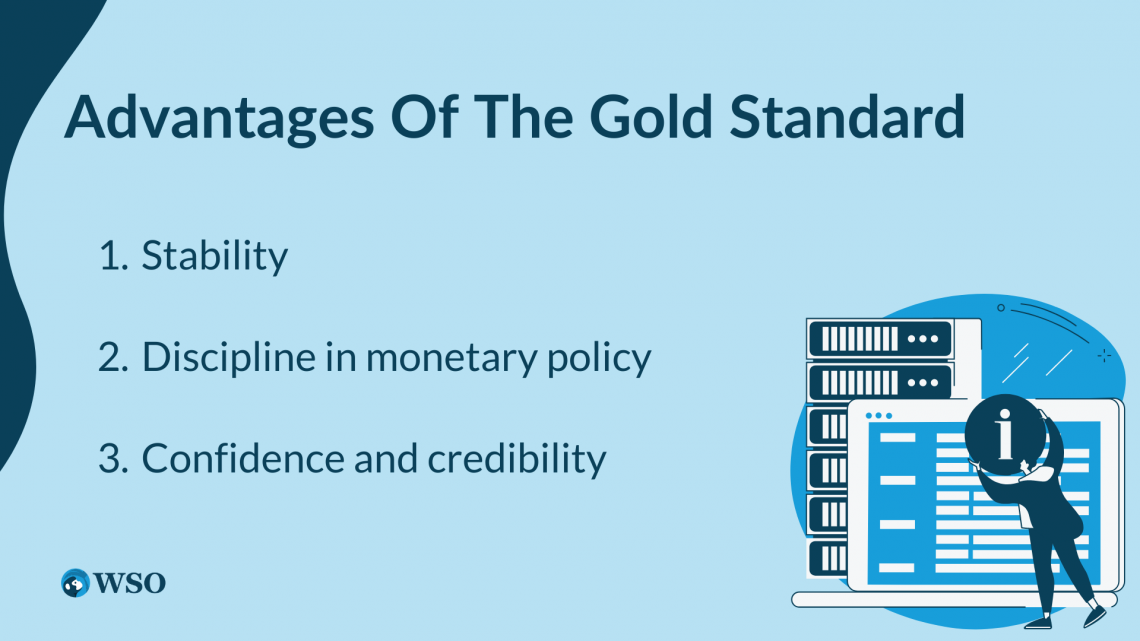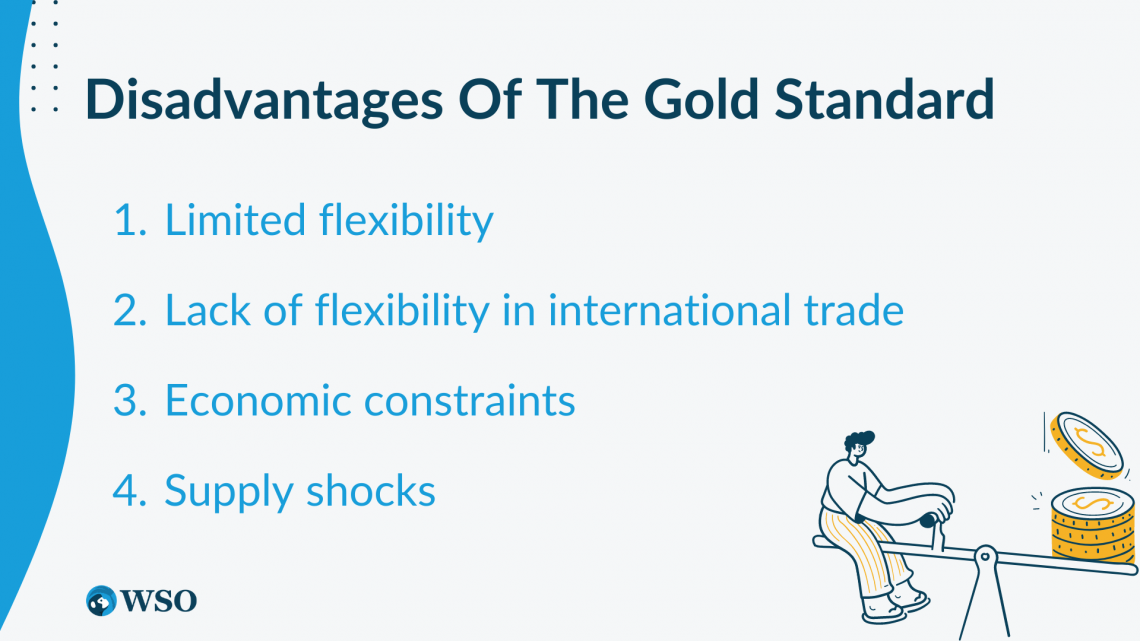Gold Standard
A universally recognized form of currency, has been used for centuries in international trade.
Gold, a universally recognized form of currency, has been used for centuries in international trade. However, the classical Gold Standard came into prominence after the 18th century.

A monetary system known as the "gold standard" involves a nation's currency being directly backed by a predetermined amount of gold. Under this arrangement, a certain amount of paper money or banknotes may be exchanged for gold.
Countries that followed the silver or bimetallic standard switched to the gold standard between the late 18th and early 20th centuries. This switch resulted from a global gold rush, in which new gold reserves were discovered across the globe.
After World War II, the Bretton Woods Agreement replaced the gold-backed standard.
According to the agreement, it was decided that the USD would be the only currency backed by gold, and all other currencies would be pegged to it. Consequently, the USD became the world’s-reserved currency.
In the present day, no country uses gold or any commodity-backed currency. Instead, all the money is what we know as fiat currency and is backed by trust in the government and a country's economic performance.
The USD is still used as a reserve currency by all economies because the US government made a deal with the Saudi government to ensure the global oil and energy trade is made in US dollars. In exchange, the US promised the Saudi Arabian government military and political support.
Key Takeaways
- Gold, as a medium of exchange, has been used alongside other metals like silver and bronze for centuries.
- In the early centuries, gold was for big payments for international trade, and silver dominated the day-to-day trades.
- It wasn't until the 19th century that gold became widely accepted as government-issued money that could be redeemed for gold.
- During the great desperation and both world wars, the countries realized that a fixed gold standard was not flexible during times of crisis.
- The Bretton Woods system was established after world war 2 in place of the traditional commodity standard where the US dollar was convertible in gold. Still, other currencies were fixed in terms of dollars.
- This system also ended in 1971, and since then, all the world currencies are not backed by any tangible commodity like gold or silver.
- The current system is known as the petrodollar system, where global energy trade is made in terms of US dollars.
History Before the gold standard
Throughout various civilizations, gold, silver, and other metals were always used as a medium of exchange for a long time.

However, the dominant form of money before the 19th century wasn't gold. Instead, silver was the primary currency for day-to-day trade in most economies; gold was used for only large payments, particularly those involving international trade.
The limited supply of gold meant that there was no official exchange rate between gold and silver for daily transactions. In addition, gold was too valuable and had no official divisibility, making its use impractical for day-to-day payments.
As silver dominated the economy, it was the de facto currency used for trade. Some major countries, like France, used a bimetallic standard where some official gold coins issued by certain governments could be exchanged for silver at a fixed rate.
As a country using bimetallic standards, it had to keep an adequate reserve of both the currency and was unstable because of Gresham's law. This made it harder for most economies to adopt such standards.
NOTE
Gresham’s Law states, "When two forms of money are in circulation, people tend to hoard the more valuable form and use the inferior form for transactions."
History of the gold standard
The discovery of the new world of North and South America gave the European powers a new supply of gold and other resources. The global gold rush that took place around the 19th made it possible for the gold standard to get prominence.

After the gold rush in California and Australia significantly increased world gold supplies, more and more countries started to entertain the idea of a single currency standard, i.e., the gold standard.
Britain was among the first to adopt it after the end of the Napoleonic Wars. However, to fully implement it, they made several changes:
- The 21-shilling guinea was discontinued. In its place, a 20-shilling gold sovereign, or £1 coin, was issued, comprising 7.32238 g of fine gold.
- The Great Recoinage of 1816 restricted the legal tender of silver coins to prevent the problems of bimetallic standards. Silver coins were declared legal tender up to £2 only.
- The convertibility of the Bank of England's banknotes to gold sovereigns was set to start in 1823 by the Resumption of Cash Payments Act of 1819.
- In 1844, Britain enacted the Peel Banking Act, which imposed restrictions on other British banks and required new currency issues to be backed by a corresponding ratio of gold reserves in the Bank of England.
- After Britain switched to the gold standard, it made its colonies also followed the same standard.
- Portugal switched in the latter half of the 19th century with its colonies.
In 1873, the German empire decided to switch to the gold standard marking the start of the international classical gold standard.
NOTE
Latin monetary union comprises France, Italy, Switzerland, Belgium, Spain, Austria-Hungary, Greece, Romania, Serbia, and other nations under different agreements.
After the German Empire, the Latin monetary union switched to the gold standard from the bimetallic standard.
The United States also adopted it in 1873 by passing the coinage act of 1873, which made the gold and silver ratio 24.0566 g silver to 1.50463 g gold, a ratio of 15.99.
Between 1875 to 1897, Scandinavian Monetary Union, Netherlands, Ottoman Empire, Austria-Hungary, and Russian Empire switched to the gold standard.
World War 1 and the Great Depression
The outbreak of World War 1 had a significant impact on the gold standard and the global economy. After the war, Germany went off the gold standard in 1914, and the war reparations it had to pay crashed the German currency.

After the war ended, many countries returned to the gold standard by 1927. However, this period of stability was short-lived, as the global economy was hit by one of the most severe economic downturns in history, known as the Great Depression.
The great depression forced the counters to suspend the gold conversion again to protect their reserves.
In 1931 many European countries suspended or completely scrapped it. The USA also suspended its gold standard in 1933 to give the government funds needed to stimulate the economy.
But this time, the countries didn't get the opportunity to reinstate the gold standard. In 1939, as the economies started to recover from the effects of the great depression, Germany invaded Poland, making the beginning of World War 2.
The impact of World War 1 and the Great Depression had long-lasting consequences on the stability and viability of the gold standard as a global monetary system.
Bretton Woods and the End of the Gold Standard
After the turmoil of two world wars and the Great Depression, it became evident that a new global monetary system needed to be established.

In July 1944, the delegation of 44 nations met at Bretton Woods, New Hampshire. As a result, a meeting named The United Nations Monetary and Financial Conference was held to discuss a new global monetary system and post-war reconstruction.
The objective of the new monitory system was to prevent the pitfall of previous systems of the rigid gold or silver standard. In addition, the new system was also needed to promote global trade without major friction between countries.
In the meeting, it was decided that other countries would fix their currency with the US dollar, and the dollar, in turn, would be fixed to gold at $35 per ounce of gold. This gave the other countries the fiscal freedom to rebuild after the war and trade with each other without thinking about their gold reserves.
NOTE
The International Monitory Fund (IMF) and International Bank for Reconstruction and Development (IBRD) (now known as World Bank) were also created to support the countries in their rebuilding efforts.
This standard worked for some time, but when the US saw its domestic inflation rise, cracks started to show in the system.
As countries experienced rapid economic growth and recovery, doubts arose about the US's ability to support the dollar's value, especially due to its involvement in the Vietnam War.
The French Government started to demand the conversion of their dollar reserve into gold. With the pressure of inflation and ever-expanding fiscal need because of the war, President Richard Nixon temporarily paused the convertibility of the US dollar into gold on August 15, 1971.

After the pause, there were various attempts to devalue the dollar. Finally, in December 1971, the conversion rate was $38 per troy ounce of gold. Another devaluation was made in 1973, where the conversion was set to $42.22 per troy ounce of gold.
However, convertibility was never resumed, and in October 1976, the US government officially removed the gold conversion and redefined the dollar. This marked the end of the gold standard.
Now every currency around the world used for trade is known as fiat money. Fiat money is not backed by any tangible commodity in theory; it is the government's fate (which issues the currency) baking the currency.
To ensure that USD should not lose its reserve currency status, the US government entered into an agreement with the Saudi Arabian government, the largest oil producer.
This arrangement ensured a steady demand for the US dollar as most countries are net oil importers. This current system is also known as the petrodollar.
Advantages and Disadvantages of the gold standard
It has the following advantages:

1. Stability
The gold standard provides stability in the monetary system, preventing high inflation or deflation without the government's intervention. If the money supply is limited in relation to the gold reserves, the monetary conditions are predictable in nature.
2. Discipline in monetary policy
It imposes discipline on government policies, as the money supply is tied to the availability of gold. This prevents excessive money printing without proper backing, promoting responsible fiscal management.
3. Confidence and credibility
A standard backed by gold has the advantage of being trusted, as gold has been considered a globally accepted currency for centuries.
It has the following disadvantages:

1. Limited flexibility
A government that uses gold-backed money will find it very challenging to stimulate the economy by implementing expansionary policies during an economic downturn because they may require additional money supply to stimulate the economy, but the gold standard restricts money creation to the available gold reserves.
2. Lack of flexibility in international trade
In a gold standard, trade between countries is difficult as every country tries to ensure that the gold is not leaving their country in large quantities.
This creates a situation where a country may need some commodity to import but will delay it or try to find an alternative to prevent the outflow of gold. In this situation, both the importer and exporter suffer as the trade is prevented due to the limitation of gold.
3. Economic constraints
Suppose a country wants to expand its economy. In that case, it has to implement expansionary policies for which the government requires money, but in a system backed by gold, without increasing the gold reserves, new money can't be printed. This will lead to slow job and economic growth.
4. Supply shocks
Gold, like any commodity, is susceptible to supply and demand shocks. For example, if there is a discovery of new gold reserves, it will affect the unit price of gold.
On the other hand, if the supply of gold stops, it will make the free market conversion of currency difficult and affect economic stability.




or Want to Sign up with your social account?